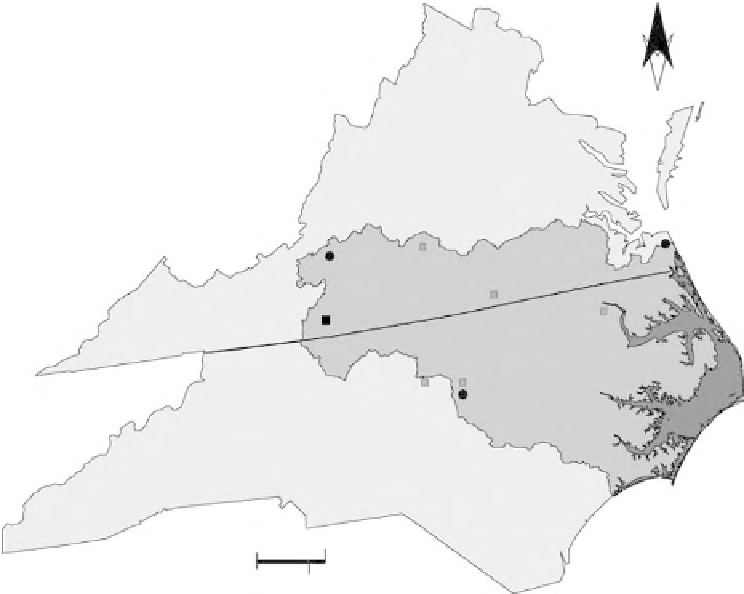Geoscience Reference
In-Depth Information
N
S
Virginia
Beach
3
Roanoke
2
4
1
Albemarle-
Pamlico Basin
VA
NC
6
Raleigh
5
50
Miles
0
Kilometers
0
50
Figure 4.1
LAI field validation site locations within the Albemarle-Pamlico Basin in southern Virginia and
northern North Carolina. (1) Hertford; (2) South Hill; (3) Appomattox; (4) Fairystone; (5) Duke
FACE; (6) Umstead.
index performance is required to characterize both the natural variability across forest stands and
the intraannual variability (phenology) associated with individual stands. To assess performance
accuracy,
validation procedures can be applied to evaluate the accuracy of remote sensor-
derived indices. A collaborative effort was established with researchers from the U.S. Environmental
Protection Agency (EPA), National Aeronautics and Space Administration (NASA), academia, and
state and municipal governmental organizations, and private forest industry to evaluate the Moderate
Resolution Imaging Spectroradiometer (MODIS) NDVI and LAI products across six validation
sites in the Albemarle-Pamlico Basin (APB), in North Carolina and Virginia (Figure 4.1).
The significance of LAI and NDVI as source data for process-based ecological models has
been well documented. LAI has been identified as the variable of greatest importance for quantifying
energy and mass exchange by plant canopies (Running et al., 1986) and has been shown to explain
80 to 90% of the variation in the above-ground forest net primary production (NPP) (Gholz, 1982;
Gower et al., 1992; Fassnacht and Gower, 1997). LAI is an important biophysical state parameter
linked to biological productivity and carbon sequestration potential and is defined here as one half
the total green leaf area per unit of ground surface area (Chen and Black, 1992). NPP is the rate
at which carbon is accumulated by autotrophs and is expressed as the difference between gross
photosynthesis and autotrophic respiration (Jenkins et al., 1999).
NDVI has been used to provide LAI estimates for the prediction of stand and foliar biomass
(Burton et al., 1991) and as a surrogate to estimate stand biomass for denitrification potential in
forest filter zones for agricultural nonpoint source nitrogenous pollution along riparian waterways
(Verchot et al., 1998). Interest in tracking LAI and NDVI changes includes the role forests play in
the sequestration of carbon from carbon emissions (Johnsen et al., 2001) and the formation of
in situ




















